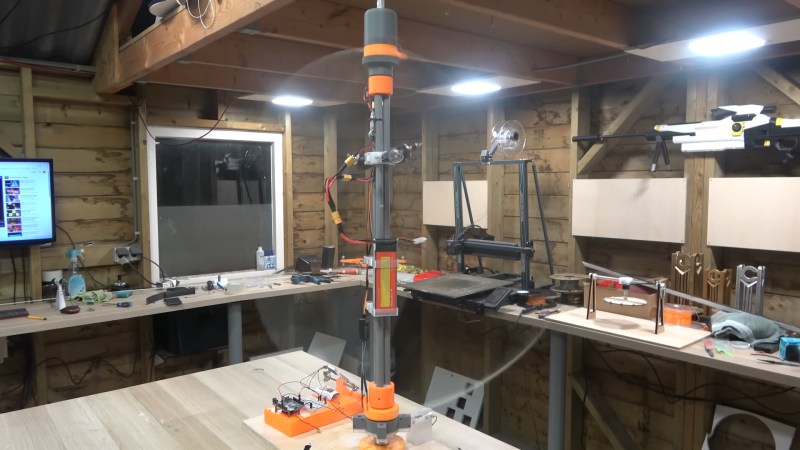LED billboards are cyberpunk-dystopian enough for most, but it can get worse. For example, this project by [Concept Crafted Creations] that takes the whole concept and takes it airborn (literally) in the form of a flying POV sphere called “Zippy”.
We love persistence-of-vision (POV) displays, and have featured plenty before, from the very complicated to the fairly simple. The idea is simple: take one or more rings of LEDs and spin them rapidly enough that the persistence-of-vision effect creates a solid image in your visual field. We covered the basics years back. “Zippy” has one ring of addressable LEDs that surrounds the thing that makes it unique: the quadcopter at its core. None of those other projects could fly, after all.
You might imagine a big, spinning ring is going to have a lot of torque to cancel out, and that is true — about 2.3 kgf — and it led to a lot of prototypes crashing early on. After trying to use flaps to direct the downwash of the quadcopter rotors to counter the spin, [Concept Crafted Creations] eventually added two extra props for yaw control, and that seemed to do the trick. We say “quadcopter” because that’s the configuration, but Zippy ended up heavy and needs eight lift motors to fly. PVC pipe and PLA aren’t the lightest build materials, after all. That’s ten props, total, plus another outrunner to spin the POV ring. All those motors, plus the current draw of the LEDs means the flight time might not impress — but Zippy sure does, at last as long as the batteries hold out.
There’s something eye-catching about POV displays, and seeing this one drifting upwards like Kang and Kodos decided to steal the Los Vegas Sphere is even more arresting. That made the crash at the end of the video sad to see, but [Concept Crafted Creations] hasn’t ruled out rebuilding it if his viewers show enough interest. So if you like what you see, head over to YouTube and leave an encouraging comment for him to try, try again.
















I get that everything is quad/octp/multicopter these days but I cant help but think that using a full sized RC helicopter frame, one could potentially ditch the tail rotor by using the “display” to counter the main rotor torque.
kgf = kilogram feet?
I had to watch the video to understand how torque is measured in units of “kgf”.
It’s not explicitly said in the video, but it’s actually kilograms force, not torque at all.
The moment arm isn’t stated, but it’s maybe 5-7 cm, so the actual torque is more like 1.4 N•m. Very close to a foot-pound for the 5 percent crowd.
Interesting and fun. With that kind of angular momentum at play it must bring in some very interesting flying dynamics. I can see how it could be very hard to fly until you get a gut feel how it behaves, kind of like a real helicopter.
I also wonder if you can offset some of that counter-torque load using the actual lift fans instead of the added weight and power consumption of the additional motors.
I had the back of an envelope handy, so:
Those countertorque fans are really working hard. At 1000 rpm (105 rad/s), and a radius of (say) 0.4 m and torque of 1.4 N•m, that’s 60 watts of power into the air. Assuming 50% propeller, motor and ESC efficiency, that’s burning at least 120 watts of battery power just to keep the body from spinning.
Not a showstopper, but still not peanuts.